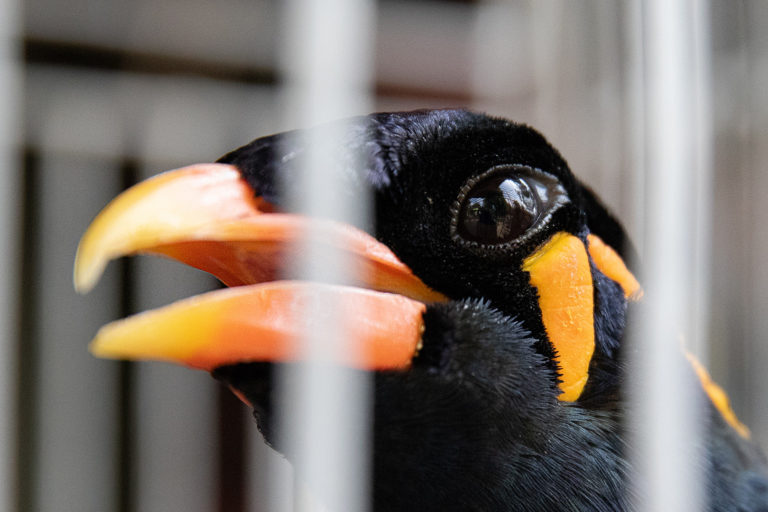
Global biodiversity loss doesn’t just result from the destruction of habitats, or even hunting species for meat. A huge number of species are threatened by trade – both alive as pets or exhibits, or dead for use in medicines.
Though people have become increasingly aware of the threat posed by the trade of high-value species, such as the elephant for ivory, and various animals such as tigers, rhinos and the pangolin for medicine, few realise the risk that the pet trade poses to the future survival of many less well-known species.
On visiting a zoo or pet shop, you may expect that the reptiles and amphibians on show are bred in captivity, but many of these animals may have been imported live. In fact, 92% of the 500,000 live animal shipments between 2000-2006 to the United States (that’s 1,480,000,000 animals) were for the pet trade, and 69% of these originated in Southeast Asia.
These exports are increasing annually from the majority of tropical countries. And without careful regulation, this trade may be disastrous for many species.
Legal trade?
Many zoos, aquaria and pet stockists formerly relied on “certified breeders” in many parts of the world (especially Southeast Asia and South America) to provide stock for pets and exhibitions. But it’s now well established that only a small proportion of these animals are, in fact, captive bred. The vast majority may be harvested from the wild and laundered to appear legal.
One such case is the common Tokay Gecko (Gecko gecko), of which Indonesia can legally export three million live annually (as designated by CITES which determines legal exports quotas of all internationally traded species), in addition to a further 1.2 million dried for its mythical medical properties.
But breeding three million of these animals would require at least 420,000 females and 42,000 males; 90,000 incubation containers and 336,000 rearing cages; plus food and hundreds of staff. All that outlay would need to be recovered at the cost of under $US1.90 per gecko, and that’s before considering death rates and the 1.2 million that are sold dried. As a result, the majority of these geckos are caught in the wild.
The same is true for an estimated 160 reptile species. Around 80% of Indonesia’s green pythons (Morelia viridis) (more than 5,337 annually) are estimated to be exported illegally, and almost the entire population of the Palawan forest turtle was captured by a single group to export across the region.
Due to collector demand for new and rare species, entire populations can be collected using academic publications to target animals as soon as they are scientifically described. At least 21 reptile species have been targeted this way and wild populations may become extinct soon after their discovery as a result. Academics have begun leaving precise locations of new species out of their publications to try prevent this.
Collector demand has driven a number of species to extinction in the wild, including the Chinese Tiger gecko Goniuorosaurus luii) and many other geckos known only to collectors and scientists. Yet these extinct in the wild, critically endangered and unclassified species are easily available from unscrupulous traders in America and Europe, via the internet or reptile fairs.
These threats are a particular risk to any newly described reptile species, particularly the reptiles of Asia as well as New Zealand and Madagascar.
For the majority of these species, legal trade has never been permitted internationally; all available animals come from illegal stock, and may represent the global population of some of these species.
An estimated 50% of live reptile exports are thought to be caught in the wild despite the fact under half of the 10,272 currently described reptile species have had their conservation status assessed. Under 8% have their trade levels controlled so developing appropriate priorities, quotas or management guidelines is almost impossible.
But this exploitation is not limited to reptiles and amphibians alone. Any species can fall prey to collectors, with primates, and orchid and bird species often suffering the same fate. More than 212 over-exploited amphibian species have been classified so far, with at least 290 species targeted for the international pet trade.
Surveys in Thailand revealed more than 347 orchid species available in a single market. They come from across the region and include many undescribed species, as well as those illegally transported into Thailand.
These species suffer the same fate as reptiles, with new discoveries often being exploited by the market, sometimes encouraged by researchers. They’re easily available over the internet, resulting in the extinction of these species based to trade alone and the refusal to accept the threat of trade.
Many bird species are also under severe extinction threat because of the pet trade. They include thousands of birds in South America, and an estimated 3.33 million annually from Southeast Asia (1.3 million from Indonesia alone).
The pressure on Indonesian birds is so severe that in just one day in a single market over 16,160 birds of around 206 species were reported to be for sale, of which 98% were native to Indonesia, and 20% occurred nowhere else in the world.
Fish have similar statistics. Up to 98% of those in aquaria are wild caught from reefs and suffer death rates of 98% within a year. As a result, wild fish populations of species, such as the clownfish, have decreased by up to 75%.
Whose responsibility?
The illegal wildlife trade is the fourth largest illegal trade globally, worth about $US20 billion annually. About half comes from Southeast Asia.
But unlike other illicit trade, much of the illegal wildlife trade is not buried in the “dark web”. Enforcement is generally so weak that traders of the majority of live animals and plants can operate in plain sight with little fear of reprisal.
The Lacey Act in the US prevents the import of live organisms from their countries of origin, in order to prevent potential laundering of wild-caught animals. But as Europe has no similar legislation, it provides a conduit in addition to an end point for trade.
The majority of the demand for these species, and especially rare species is from European and North American collectors. But, as only a tiny portion of this trade is regulated (2% of international amphibian trade, and 10% of global reptile trade), urgent action is needed to protect vulnerable species from possible extinction.
As many species of reptiles, amphibians and orchids have not been listed by CITES (due to insufficient information, or recent discovery), there is no real regulation in the animal trade. And customs officers cannot be expected to distinguish between a rare and a common orchid or frog, so simpler restrictions are required to prevent this potentially damaging trade.
Innocent until proven guilty?
As so many species have no CITES classification perhaps what we need is a paradigm shift so that only species classed as tradeable, and certified as such can be traded. This would mean all specimens without a certificate could not be transported internationally.
At present, tracking trade of whole groups is difficult as organisations that are in position to do this, such as the World Customs Organisation, do not include records for amphibians.
Many species in the West can only have arrived through illegal routes, yet domestic trade of these species once in a country is currently unrestricted. Licensing or certification systems should be created as a mandatory part of the sale of any taxa vulnerable to exploitation, with confiscations and punishments used to assist compliance.
Collectors of live animals and plants are predominantly hobbyists, so the majority are unlikely to go to great lengths to procure specimens if any level of enforcement were instigated. Such action also needs to extend to finally restrict the thriving trade via the internet in these species which currently exists.
Though pledges have been made by European governments to restrict wildlife trade, their efforts normally fail to account for the huge numbers of species at risk as pets and live specimens. Given the laundering and corruption in these species ranges, restrictions on import by consumer countries are urgently needed.
If we want any future for wild populations of these species, drastic action is needed to control their international and domestic trade. Without such action, we can expect to see the loss of many rare species to greed alone.




